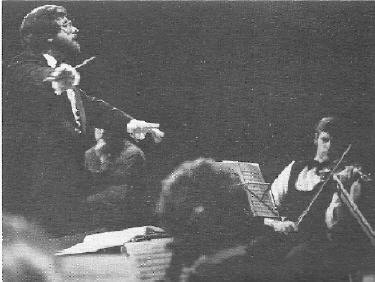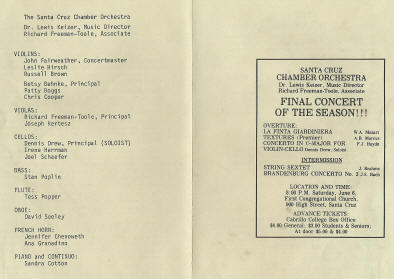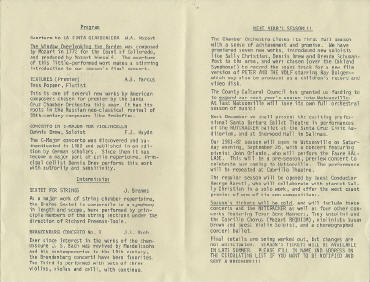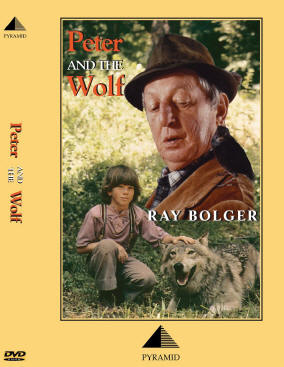THE SANTA CRUZ CHAMBER ORCHESTRA
Lewis Keizer, Founder and Conductor 1979-1987
MY CONDUCTING CAREER
In
1975 I was serving as Vice President of the Musicians Union, Santa Cruz (now
defunct). I found a treasure trove of symphonic band music--scores and all the
parts--scattered in stacks all over the floor, some on shelves. These were
transcriptions of symphonic movements, ballet music, and other classics that had
been made either by the composers themselves (Tchaikovsky, Dvorak, Gershwin,
etc.) or others in nineteenth and early twentieth centuries. Why? Because most
cities did not have symphony orchestras in those days, but did have very skilled
bands. This was the library of the old Santa Cruz Beach and Boardwalk company
who used to hire San Francisco Symphony musicians at $2.50/day to come,
rehearse, and perform these works free for the public in the band shell.
Luminaries like Tchaikovsky had vacationed in Santa Cruz and appeared for
performances of his works.
However things had changed since those halcyon days. After the Great Depression and WWII, it became too expensive to bring San Francisco musicians to Santa Cruz, Moreover, the symphonic band repertoire was so difficult to perform that local bands couldn't play it. So Skip Littlefield, President of the company, had donated the library to the local Musicians Union. It had lain there untouched and forgotten for decades. I carefully organized and catalogued the library, which had a value of about $80,000 if any of the arrangements were even still in print. Then I obtained funding from the Musicians Trust Fund and Santa Cruz Arts Commission to establish a summer outdoor symphonic band series and hired the best wind and percussion personnel from San Jose and Santa Cruz Symphonies. We named it the New Hastings Symphonic Band in honor of George Hastings, who had established the first Santa Cruz town band right after the Civil War. We exhibited his antique cornet at the library and did a lot of publicity. Our typical weekend schedule was to rehearse for two hours, take a lunch break, then perform a one-hour outdoor concert at the Duck Island Stage. We also performed the Gershwin Rhapsody in Blue and Gershwin Piano Concerto, soloist John Orland, outdoors for the dedication of the Town Clock. Click for symphonic band selections HERE for parts of a demo tape I made our first summer to get funding.
By the end of the first summer I'd gleaned enough experience as a conductor to begin developing myself as a symphonic conductor. I produced and conducted the first-ever full performance of Tchaikovsky's Nutcracker Ballet at the Santa Cruz Civic Center as a fund-raiser for the Band. I was serving at the time as Personnel Manager for the Santa Cruz Symphony, so conducted that orchestra for four weekend performances to packed houses of about 1500 each. Click HERE for selections from a three-hour Nutcracker Ballet performance. The Christmas weekend performances were advertised in all schools. The children's ticket sold for $2.50, adults $5--such a deal! I brought in the Santa Barbara Ballet with soloists from New York. But I was also hired by the Los Gatos Ballet Theater to form and conduct a ballet orchestra for their production of Nutcracker at the San Jose Civic Center. I hired personnel from the San Jose Symphony, many of whom were already members of the New Hastings Band. Those performances were also very successful. I was on my way to becoming a symphonic conductor, so by the next season I had founded and established an entire winter season for my new Santa Cruz Chamber Orchestra, which consisted of first-chair players from San Jose, Santa Cruz, and Monterey Symphonies. It was initially funded as a cultural non-profit by my Popper-Keizer School with a $20,000 grant from the Lingafelter Foundation. From now on the Christmas Nutcracker performances using the new chamber orchestra would fund each new winter season of performances, with an occasional Messiah Sing-Along inserted into the season.




So every summer I conducted a New Hastings Symphonic Band series, then every school year a full season of Santa Cruz Chamber Orchestra performances. Our main venue was the Cabrillo College Theater in Aptos, and we often featured Cabrillo College music faculty personnel as soloists. But we also expanded to Watsonville and even the Sherwood Theater in Salinas for extra Nutcracker performances. My personnel made better than union scale wages, but I donated my services and sometimes took a small fee if there was money. Our performances featured wonderful piano, harpsichord, violin, viola, cello, French horn, and guitar soloists, many of whom had won international contests. We also solicited new works of music to premier from the U.S., Canada, and Mexico. On every concert we had a Mozart, Haydn, Ravel, Debussy, or other classic small orchestra work, a soloist, and we premiered new music. We also featured wind and brass chamber performances by our personnel, such as the Amici Wind Quintet (click HERE).
Our local professional musicians were quite excellent. We did only two three-hour rehearsals to prepare a each concert using two basses, two cellos, two violas, two first and two second violins, plus woodwinds, flutes, French horn and other brass as needed, and one tympanist. Here is our performance of Smetana's Overture to the Bartered Bride. It is technically quite demanding for strings and winds. Our Assistant Conductor Richard was far more valuable as Principle Violist than on the podium, as you will hear with the long fugue that opens with violas. Click HERE.
Click HERE for Tenor Gene Manners singing Benjamin Britten's Serenade, and HERE for his Italian Arias. Click HERE and HERE for selections from Haydn symphonies. Click HERE for a little Mozart. HERE for a little Schubert. Click HERE and HERE and HERE and HERE for new music we premiered. Click HERE for John Orlando performing a piano concerto movement.
Our Popper-Keizer School had received large grants several years in a row from the Burchfield Foundation thanks to Catherine Burchfield, a cellist and teacher on our faculty. In gratitude I composed a short tone poem called Winter Visions and dedicated it to the Burchfields. It was my one and only attempt at orchestral composition. I drew upon techniques developed by Ravel, Debussy, and American composers like Gershwin. My goal was to experiment with the many kinds of tone color that could be evoked from a small chamber orchestra. Due to heavy rehearsal schedule for the rest of our concert, we were able to read through the piece only once before this performance, which was recorded at the Crown Dining Hall, U.C.S.C. I was disappointed in the recording, but my son Rafael asked about it, so HERE it is.
In 1986 we were contracted by Shire Films to record the sound track and appear in a new version of Prokofiev's Peter and the Wolf set in old California and designed to replace the old Disney cartoon version in American public schools. I had hot-recorded all my concerts, meaning that each section had a closely-placed mike to make the small orchestra sound more lush. We used the same technique for this recording with excellent results. The film starred Ray Bolger as narrator and several of my students from Popper-Keizer School, including the role of Peter. It won an award at the Cannes Film Festival and for six years running was shown on the CBS Children's Film Festival. I appeared in the film several times as Ray introduced the instruments of the orchestra. The VHS has been made into a DVD and is still available through Pyramid on the internet.
I adopted a philosophy of conducting based on the methods of the great and beloved conductor Felix Mendelssohn. Instead of trying to be a control-freak who insisted on conducting every note of an ad libitum solo cadenza and taking all the bows for a performance, I worked collegially with my musicians. Here's what is required in my philosophy: 1. The conductor must be an excellent musician who is respected by the players; 2. issues like bowing and certain kinds of interpretation are worked out by concertmasters and section leaders, not dictated by the conductor; 3. musicians solve their own technical issues without a conductor forcing them to repeat over and over until a passage sounds acceptable to him/her; 4. the conductor chooses repertoire, potential soloists, and new works in consultation with musicians; 5. the conductor is one musician just like the others, but whose job is to facilitate rehearsals and performances--not to wildly over-conduct or make himself the center of attention. For two poor-quality private recordings of my rehearsal methods, click HERE and HERE.
The Santa Cruz Chamber Orchestra went belly-up in 1987 for two reasons. First, with funding from Steve Wozniak the Cleveland Ballet invaded San Jose to present a rival Nutcracker to the San Francisco Ballet's version. The Nutcracker was a main fundraising ticket for SF Ballet (as for all ballet companies), and bringing in the Cleveland Ballet was like bringing a bull into a China shop. Several smaller companies, including the Los Gatos, lost so much money they had to close up shop, and SF Ballet was in the red for several years following. In our case, that was the first year we lost money on our Nutcracker. In addition to that, Cabrillo College precipitously raised their theater rental fees. We couldn't raise enough money to stay solvent, so we had to fold up. The Cabrillo Music faculty like pianist John Orlando, violinist Susan Brown, and Tenor Gene Manners no longer had us as a reliable venue for high-quality performances. It was a very sad time. I'm sure the Woz had no idea that his attempt at cultural enrichment for Silicon Valley would have so many unintended consequences, and I doubt that the Cabrillo administration realized what its fee hikes would do to us.
[Incidently, the San Jose Symphony, oldest symphony orchestra on the West Coast re-founded by virtuoso cellist protege of Pablo Casals and conductor Willem Van Den Burg in 1937, also went out of business later in spite of the dot-com boom. I guess geeks don't like real music. I spent time with Van Den Burg in his apartment where he was recording his final definitive versions of the Bach Unaccompanied Cello Suites. He served me food spiked with his favorite incredibly hot horseradish. He died in 1992.]